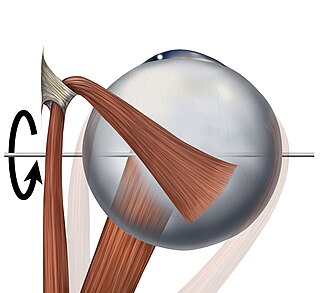
The rectus abdominis muscle, also known as the "abdominal muscle" or simply the "abs", is a pair of segmented skeletal muscle on the ventral aspect of a person's abdomen. The paired muscles are separated at the midline by a band of dense connective tissue called the linea alba, and the connective tissue defining each lateral margin of the rectus abdominus is the linea semilunaris. The muscle extends from the pubic symphysis, pubic crest and pubic tubercle inferiorly, to the xiphoid process and costal cartilages of the 5th–7th ribs superiorly.

The superior rectus muscle is a muscle in the orbit. It is one of the extraocular muscles. It is innervated by the superior division of the oculomotor nerve (III). In the primary position, its primary function is elevation, although it also contributes to intorsion and adduction. It is associated with a number of medical conditions, and may be weak, paralysed, overreactive, or even congenitally absent in some people.

The inferior rectus muscle is a muscle in the orbit near the eye. It is one of the four recti muscles in the group of extraocular muscles. It originates from the common tendinous ring, and inserts into the anteroinferior surface of the eye. It depresses the eye (downwards).

The lateral rectus muscle is a muscle on the lateral side of the eye in the orbit. It is one of six extraocular muscles that control the movements of the eye. The lateral rectus muscle is responsible for lateral movement of the eyeball, specifically abduction. Abduction describes the movement of the eye away from the midline, allowing the eyeball to move horizontally in the lateral direction, bringing the pupil away from the midline of the body.

The extraocular muscles, or extrinsic ocular muscles, are the seven extrinsic muscles of the human eye. Six of the extraocular muscles, the four recti muscles, and the superior and inferior oblique muscles, control movement of the eye and the other muscle, the levator palpebrae superioris, controls eyelid elevation. The actions of the six muscles responsible for eye movement depend on the position of the eye at the time of muscle contraction.
The rectus femoris muscle is one of the four quadriceps muscles of the human body. The others are the vastus medialis, the vastus intermedius, and the vastus lateralis. All four parts of the quadriceps muscle attach to the patella by the quadriceps tendon.

Phygelius, common names Cape fuchsia or Cape figwort, is a genus of flowering plants in the family Scrophulariaceae, native to wet slopes and banks in southern Africa. They are evergreen shrubs often treated as perennials in colder climates. They bear many pendent tubular flowers over a long period in summer, in shades of white, yellow and red. The vague similarity of the blooms to fuchsias has led to the common name Cape fuchsia, though they are not closely related.

Modiolus, the horsemussels, are a genus of medium-sized marine bivalve molluscs in the family Mytilidae.
Hydroporus rectus is a species of predaceous diving beetle in the family Dytiscidae. It is found in North America.

Eropterus is a genus of net-winged beetles in the family Lycidae. There are about 10 described species in Eropterus.
Eusphyrus rectus is a species of fungus weevil in the beetle family Anthribidae.
Eupsenius is a genus of ant-loving beetles in the family Staphylinidae. There are about six described species in Eupsenius.
Goniocloeus is a genus of fungus weevils in the beetle family Anthribidae. There are at least 40 described species in Goniocloeus.
Brachycorynus is a genus of fungus weevils in the beetle family Anthribidae. There are at least three described species in Brachycorynus.
Selvadius is a genus of amber lady beetles in the family Coccinellidae. There are at least four described species in Selvadius.
Brachycorynus rectus is a species of fungus weevil in the beetle family Anthribidae.
Ahasverus rectus is a species of silvanid flat bark beetle in the family Silvanidae. It is found in North America.
Sphenophorus rectus is a species of beetle in the family Dryophthoridae. It is found in North America.
Chanbria regalis is a species of wind scorpion in the family Eremobatidae.
Scolytomimus rectus, is a species of weevil found in Sri Lanka. Larval host plant is Osbeckia.







